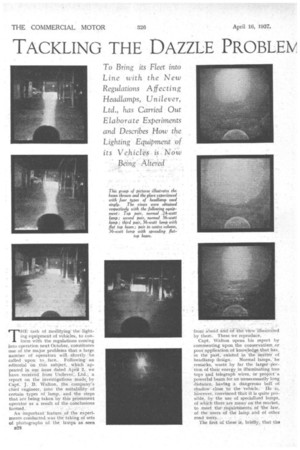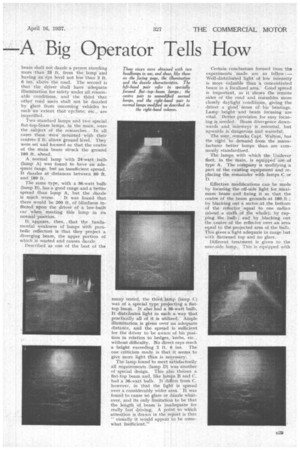TACKLING THE DAZZLE PROBLEN
Page 42

Page 43

Page 44

If you've noticed an error in this article please click here to report it so we can fix it.
--A Big Operator Tells How
THEtask of modifying the lighting equipment of vehicles, to conform with the regulations coming into operation next October, constitutes one of the major problems that a large number of operators will shortly be called upon to face. Following an editorial on this subject, which 'appeared in our issue dated April 2,. we have received from Unilever,. Ltd.; a report on the investigations made by Capt. J. B. Walton, the 'company's chief engineer, into the suitability of certain types of lamp, and the steps that are being taken by this prominent operator as a result of the conclusions
formed. .
An important feature of the experiments conducted was the taking of sets of photographs of the lamps as seen
B28
front ahead and of -the view 'illustthed by them. These we reproduce.
Capt. Walton opens his report by commenting upon the conservatism or application-of knowledge that has. in the past, existed in -the matter of headlamp deSign. Normal lamps, he remarks, waste by far the larger portion of their energy, in illuminating tree tops and telegraph wires, or project a powerful beam. for an 'unnecessarily long distance, having •a dangerous belt -of shadow close to the vehicle. He • is, however, convinced tha.t•it is quite possible, by the use of specialized laMps, of which there are many on the market, to meet the l'equireirients of The law, of the users of the lamp and of other
road users. •
The first of these is, briefly, that the
beam shall not dazzle a person standing more .than 25 ft. from the lamp and having an eye level not less than 3 ft. 6 ins. above the road. The second is that the _ driver shall have adequate illumination for safety under all reasonable conditions, and the third that other road users shall not be dazzled by glare from oncoming vehicles to such an extent that cyclists, etc., are imperilled.
Two standard lamps and two special flat-top-beam lamps, in the main, were the subject of the researches. In all cases these Areth mounted with their centres 2 ft. above ground level. They -were set and focused so that the centre of the main beam struck the ground 180 ft. ahead.
A normal lamp with 24-watt bulb (lamp A) was found to have an adequate range, but an insufficient spread. It dazzles at distances between 80 ft. and 180 ft.
The same type, with a 36-watt bulb (lamp B), has a good range and a better spread than lamp A, but the dazzle
is mach worse. It was found that there would be 200 ft. of blindness inflicted uponthe driver of a low-built car when meeting this lamp in its normal positidn.
It appears, then, , that the fundamental weakness of lamps with parabolic reffectors is that they project a diverging beam, the upper portion of which is wasted and causes dazzle.
Described as one of the best of the
many tested, the third lamp (lamp C) was of a special type:projecting a flattop beam. It also had a 36-watt bulb. It distributes light in such a way that practically all of it is utilized.Ample illumination is given over an adequate distance, and the spread is sufficient for the driver to be aware of his position in relation to hedges, kerbs, etc., without difficulty. No direct rays reach a height exceeding 2 ft. 6 ins. The one criticism made is that it seems to give more light than is necessary.
The lamp found to meet satisfactorily all requirements (lamp D) was--another of special design. This also throws a flat-top beam and, like lamps B and C, had a 36-watt bulb. It differs from C, however, in that the light is spread over a considerably wider area. • It was found to cause no glare or dazzle whatever, and its only limitation to be that the length of beam is inadequate for really 'fast driving: A point to which attention is drawn' in the report is that " visually it Would appear to be some what hieffidient.'' • ' Certain conclusions formed from the experiments made are as follow:— Well-distributed light of low inthnsity is more Valuable than a Concentrated beam in a localized area.Good spread is important, as it shows the remote sides of the road and resembles more closely daylight conditions, giving the driver a good sense of his bearings. Lamp height and beam focusing are vital. Better provision for easy focusing is needed. Beam divergence downwards and sideway's is essential, but upwards is dangerous and wasteful.
The user; remarks Capt. Walton; has the right to demand from the manufacturer better lamps than are commonly standardized, The lamps with which the Unilever fleet, in the Main, is equipped are. of type A. The company is modifying a part of the existing equipment and replacing the remainder with lamps C or n. .
Effective modifications can be made by focusing the off-side light for Maximum beam and fixing it so that the centre of the beam grounds at 180Jt.; by blacking out a sector at.the bottom of the reflector equal •to one radian (about a sixth of the whole); by capping the bull); and by _blacking out the centre of the reflector over an area equal to the projected area of the bulb. This gives a light adequate in range but with flattened top and no glare.
Different treatment is given to the near-side lamp.. This'll equipped with a flat-filament bulb, focused for spread, and is then permanently deflected two degrees to the near side and dipped three degrees. With this arrangement it is possible to look straight at both lamps from a distance of 200 ft., or nearer, without experiencing the least inconvenience.
. For focusing. and setting the lamps of . the fleet a practical, time-saving method was evolved. After the first pair of lamps had been adjusted correctly a canvas screen was rigged up in the garage, and the vehicle driven to a position 20 ft. away from the screen
and pointing towards it. The light centres on the screen were then marked, the screen becoming, as it were, a target.
It was then used as a jig, the other vehicles being placed, one by one, in the exact position of the first, and their lamps set and . focused to the marks made on the screen by those of the vehicle with the " master " setting.
In the case of the vehicles, the fighting equipment of which is being replaced, lamps C or D are being employed. . That on the near, side is set two degrees to the left and dipped by the same amount, the off-side lamp being pointed • straight ahead and grounded at 180 ft. The dipping switch merely extinguishes the latter, and is used primarily to make a courtesy gesture when another vehicle dips, becauso there is normally no need to do so to prevent dazzle.
Unilever, Ltd., as a result of theso researches, has established certain standards useful for comparison and made a definite contribution to road safety. Altruistically, the company is giving others the benefit of its experience. Capt. Walton has available a mass of data and generously offers to give the benefit of his experience or advice to any reader of The Commercial Motor.




























































































